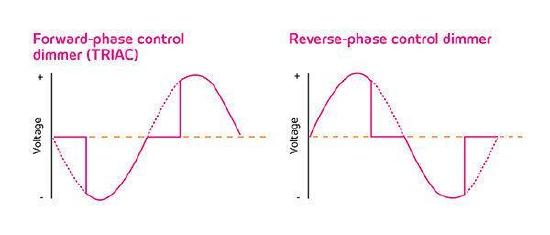Four Rules of Echoflex Phase Dimmers
Overview
The Echoflex phase dimmers (ER6CD and ER12CD) are versatile products. They can dim many types of line voltage lighting loads with equal performance, but there are some considerations to take into account to make sure they behave optimally.
The Four Rules
First rule of phase dimmers: All lighting loads on any one phase dimmer should be the same type of lamp.
Tungsten and incandescent lamps dim differently than LED or fluorescent lamps. Ballasts and LED drivers affect how current flows downstream more so than halogen or tungsten lamps, and as such, they often cause issues with one another's dimming performance when on the same line due to their differing needs.
Halogen lamps always have a transformer, usually magnetic, so check specifications first. Echoflex phase dimmers do NOT function well with magnetic transformers.
Second rule of phase dimmers: All lighting loads being controlled by the phase dimmer should be the same type of load.
Mixing fixture types on a circuit could mean you have forward phase and reverse phase lighting loads on the same circuit. The phase dimmer will try to automatically identify the load type and choose either reverse or forward phase. If there is a mixture of both reverse and forward phase fixtures, then you will likely see oscillation when turning the lights ON and poor dimming performance.

Third rule of phase dimmers: Minimum Dimming Level and OFF are not the same thing
The minimum dimming level should never be 0%, even if the lamp can support dimming to 0%. Echoflex controllers will save the last manually set dimmed level from a wall switch. The next time someone enters the room and clicks the switch for ON, it will recall this saved value. If the value is 0%, or even < 5%, the light output will be negligible and appear to be OFF, and the user will think there's something wrong.
Example: If a user is manually dimming a light down and goes to the minimum level then leaves for the day. Later, the local occupancy sensor shuts the light off. The user returns the next day and clicks the switch for ON. The light will turn ON and resume the last days previous dimmed state. If the dimmed value was below the visible light output from the fixture, it will appear as if the light is still OFF.
Fourth rule of phase dimmers: LED and fluorescent fixtures minimum dimming levels should be dictated by the driver/ballasts ability to operate in low voltage conditions
Some early LED drivers would not perform well at low voltage and the result was flicking lights. Todays drivers perform better but there is still a threshold where they will stop driving the LEDs. If a facility is keen to have the fixtures dim to the lowest possible level, it may take some trial and error to find that exact level - writing to the minimum dimming level using Garibaldi software then testing with a switch. Does the light go OFF or dim to a level just above OFF, is there any flicker?
